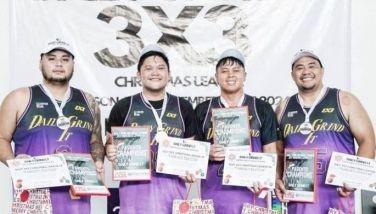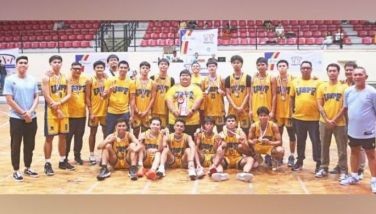Business rallies behind Laguna Lake rehab
September 8, 2002 | 12:00am
Laguna de Bay, the largest lake in the Philippines, and considered one of the living lakes in the world during the 6th Living Lake Conference in Russia in 2001, has been the object of intense rehabilitation efforts by the Laguna Lake Development Authority (LLDA). Considerable success has been achieved because of the strong cooperation from the river councils in 24 micro-watersheds of the Laguna de Bay basin, where the business sector has been strongly visible.
The unique success of these river councils lies in their being community-based and multi-sectoral. For example, one of the river councils, the San Cristobal River Enhancement Defenders (SaCRED) has for members, companies that do business in the area, as well as barangays, government agencies, NGOS, and civic organizations. Industry, in particular, plays an active part in the rehabilitation efforts. A prime mover behind SaCRED is its president, Tess Cayton, plant manager of Bayer Philippines, located in Canlubang, Laguna. The company’s water effluent empties into the Laguna Lake, and its involvement in SaCRED includes sharing its reputed expertise on environmental protection with the community.
Besides Cayton, members of SaCRED include representatives of other companies that do business in the area like ACS Manufacturing, Asian Transmission, Asia Textile Mills, Avon Products, BASF Philippines, Baxter Philippines, Canlubang Group of Companies, Coca-Cola Bottlers, Coca-Cola Export, Fujitsu Computer Products, Interphil Laboratory, La Tondeña, Litton Mills, Samsung Electro-Mechanics, Sander Aircon, Sunpack Container & Packaging, Terelay Investment & Development, Westpoint Industrial Mills, White Cap South East Asia, and Wyeth Philippines. Before SaCRED was established in 2000, the San Cristobal River was identified as the second dirtiest river in the entire region.
Recognizing the strong public-private partnerships of the river council, the United States-Asia Environment Partnership (US-AEP) sponsored a two-day conference at the EDSA Shangri-La recently to strengthen the capability of the LLDA river councils in the area of community-based environment protection and management. Special resource persons were top environmentalists from the Chesapeake Bay area in the USA that included Jane Nishida, Maryland’s former Secretary of the Environment, John Tippett of the Friends of the Rappahannock, Bob Murphy of the Alliance for the Chesapeake Bay, and Menchu Martinez of the US Environmental Protection Agency, Chesapeake Bay Program.
The conference was an offshoot of a study tour of the Chesapeake Bay in June 2002 for LLDA officials and representatives of three selected learning sites, among them Cayton of SaCRED. The US-AEP sponsored tour gave participants a close look of the Chesapeake Bay Rehabilitation Program and other successful community-based initiatives and public-private partnerships for the management of environmental resources in the United States.
Since SaCRED’s establishment, it has conducted regular clean-up activities of the river and its surrounding areas. One of its more recent activities was the planting of some 800 trees in the San Cristobal bridge area. The group also plans to adopt and support the eight to 12 barangays who have agreed to take the responsibility of ensuring that the river’s waters are always kept clean.
According to Cayton, the study tour in Chesapeake and the conference in Manila has given SaCRED the opportunity to reassess its plans and to adapt whatever lessons they have learned from the Chesapeake Bay Rehabilitation Program. One very important lesson is to get the community involved, especially the local government units and the politicians. That is why during the two-day conference, a call for action for community involvement was made. There and then, pledges of commitment were elicited from representatives of local government.
Together with Jose Cariño, the regional organizer of the LLDA river councils, Cayton has been invited by the US-AEP to speak at a subsequent conference to be held in Thailand this month. They will share their uniquely successful experience in the Philippines. Of special interest is how they were able to gather together industry, government, communities and other stakeholders, and motivate them to pool resources, and raise funds for the rehabilitation of the San Cristobal River and the Laguna Lake.
The unique success of these river councils lies in their being community-based and multi-sectoral. For example, one of the river councils, the San Cristobal River Enhancement Defenders (SaCRED) has for members, companies that do business in the area, as well as barangays, government agencies, NGOS, and civic organizations. Industry, in particular, plays an active part in the rehabilitation efforts. A prime mover behind SaCRED is its president, Tess Cayton, plant manager of Bayer Philippines, located in Canlubang, Laguna. The company’s water effluent empties into the Laguna Lake, and its involvement in SaCRED includes sharing its reputed expertise on environmental protection with the community.
Besides Cayton, members of SaCRED include representatives of other companies that do business in the area like ACS Manufacturing, Asian Transmission, Asia Textile Mills, Avon Products, BASF Philippines, Baxter Philippines, Canlubang Group of Companies, Coca-Cola Bottlers, Coca-Cola Export, Fujitsu Computer Products, Interphil Laboratory, La Tondeña, Litton Mills, Samsung Electro-Mechanics, Sander Aircon, Sunpack Container & Packaging, Terelay Investment & Development, Westpoint Industrial Mills, White Cap South East Asia, and Wyeth Philippines. Before SaCRED was established in 2000, the San Cristobal River was identified as the second dirtiest river in the entire region.
Recognizing the strong public-private partnerships of the river council, the United States-Asia Environment Partnership (US-AEP) sponsored a two-day conference at the EDSA Shangri-La recently to strengthen the capability of the LLDA river councils in the area of community-based environment protection and management. Special resource persons were top environmentalists from the Chesapeake Bay area in the USA that included Jane Nishida, Maryland’s former Secretary of the Environment, John Tippett of the Friends of the Rappahannock, Bob Murphy of the Alliance for the Chesapeake Bay, and Menchu Martinez of the US Environmental Protection Agency, Chesapeake Bay Program.
The conference was an offshoot of a study tour of the Chesapeake Bay in June 2002 for LLDA officials and representatives of three selected learning sites, among them Cayton of SaCRED. The US-AEP sponsored tour gave participants a close look of the Chesapeake Bay Rehabilitation Program and other successful community-based initiatives and public-private partnerships for the management of environmental resources in the United States.
Since SaCRED’s establishment, it has conducted regular clean-up activities of the river and its surrounding areas. One of its more recent activities was the planting of some 800 trees in the San Cristobal bridge area. The group also plans to adopt and support the eight to 12 barangays who have agreed to take the responsibility of ensuring that the river’s waters are always kept clean.
According to Cayton, the study tour in Chesapeake and the conference in Manila has given SaCRED the opportunity to reassess its plans and to adapt whatever lessons they have learned from the Chesapeake Bay Rehabilitation Program. One very important lesson is to get the community involved, especially the local government units and the politicians. That is why during the two-day conference, a call for action for community involvement was made. There and then, pledges of commitment were elicited from representatives of local government.
Together with Jose Cariño, the regional organizer of the LLDA river councils, Cayton has been invited by the US-AEP to speak at a subsequent conference to be held in Thailand this month. They will share their uniquely successful experience in the Philippines. Of special interest is how they were able to gather together industry, government, communities and other stakeholders, and motivate them to pool resources, and raise funds for the rehabilitation of the San Cristobal River and the Laguna Lake.
BrandSpace Articles
<
>
- Latest
Latest
Latest
April 10, 2024 - 5:12pm
By Ian Laqui | April 10, 2024 - 5:12pm
March 4, 2024 - 3:32pm
By Ian Laqui | March 4, 2024 - 3:32pm
March 4, 2024 - 2:12pm
By Kristine Daguno-Bersamina | March 4, 2024 - 2:12pm
February 17, 2024 - 2:31pm
February 17, 2024 - 2:31pm
February 13, 2024 - 7:24pm
By Gaea Katreena Cabico | February 13, 2024 - 7:24pm
Recommended



























